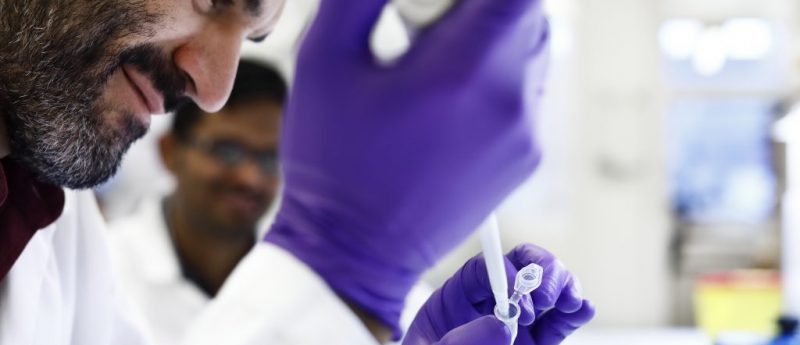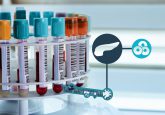Mercodia Lispro NL-ELISA – the first Lispro ELISA optimized for use in drug development

Authors
Frida Henningson Johnson, Hampus Elofsson, Esrat Qamrul-Ehsan and Hanna Ritzén, Mercodia AB (Uppsala, Sweden)
Frida Henningson Johnson is Global Product Manager at Mercodia AB. With a PhD in Biochemistry and several years in PI positions at Uppsala University (Uppsala, Sweden), her scientific knowledge is substantial. After earning a degree in Journalism, she has worked as a freelance scientific journalist and communicator, as well as scientific editor for several companies and scientific organizations. She is now part of the marketing team at Mercodia AB, where her scientific skills are perfectly mixed with her communicative proficiencies.
Introduction
Lispro is a rapid insulin analog [1] which is sold under the name Humalog® by Eli-Lilly. Lispro has the same amino acid sequence as native insulin with the minor difference of one amino acid; the primary sequence has been altered with the inversion of Proline and Lysine in position 28 and 29 in the B-chain of the peptide. Consequently, this gives insulin lispro a faster rate of absorption and shorter duration of action than native insulin, which makes it more convenient for post-prandial control of blood glucose for Diabetes Type 1 (T1D) patients. This article describes the newly developed Mercodia Lispro NL-ELISA, and its validation according to EMA/FDA guidelines.
Lispro measurements in drug development
A Lispro ELISA with high standard specifications and regulatory validations can be used in several applications and phases of drug development, for example:
Pharmaceutical studies in biosimilar development
Humalog® has been on the market for a long time and is, by many, considered to be the golden standard for short-acting insulin. Therefore, it will often be used as the reference drug in clinical studies for any short-acting insulin. When a new drug, based on lispro as the active substance is developed PK/PD-profiles, safety and/or efficacy need to be investigated. In these cases, the Mercodia Lispro NL-ELISA can be used both to measure the biosimilar drug directly and to generate Humalog data for comparison.
Combinational therapy development
Studies investigating combinational therapy are performed both by pharmaceutical companies and in academic research. For long, metformin has been used as the first-line treatment for Type 2 Diabetes and it is still used among this group of patients, but studies are also performed investigating metformin in combination with insulin analogs (like lispro).
MedTech development
For decades, insulin injections have been used for diabetes treatment, and with technical advances the administration of insulin is evolving. Drug delivery is a key aspect within the diabetes field and alternative, non-traditional methods are developed, such as transdermal patches and inhalation systems but also insulin pumps and closed loop systems/artificial pancreases. There is a high demand for new technical equipment that can relieve patients with diabetes from using needles several times a day and that can help some patients managing their blood glucose at a more stable level. If an insulin analog such as lispro is to be used in the new technical development, there is a need for an accurate measurement of it.
Optimized for pharma
Special needs for drug development
Traditionally, immunoassays are developed for research use only (RUO) or in vitro diagnostics (IVD), but since the demand for biomarker analysis in drug development has grown, a need so far unmet, for ‘well-defined’ commercial kits that can be utilized in a drug development setting has arisen.
During the 12th meeting of the Global Contract Research Organization Council (GCC) for Bioanalysis the last year adaptation of commercial immunoassay kits for the validation of biomarker methods was discussed. The regulated environment that contract research organizations operate in presents significant challenges and to summarize the discussions on this topic at the meeting a White Paper has been prepared and recently published in Bioanalysis Journal [2].
In the White Paper GCC describes recommendations for immunoassay kits for the analysis of biomarkers, that will be used for regulated drug development. Biomarker decisions are dependent on the quality of the data, which is ensured when the biomarker assays are appropriately characterized and suitable for intended use. The authors scrutinize biomarker assay validation, and a two-level kit classification scheme is proposed to provide bioanalytical laboratories a standardized expectation of the contents of commercial kits before internal validation, to reduce time, cost and regulatory hurdles.
In addition, a survey was conducted amongst GCC members to investigate the needs in the community. It became clear that most GCC members use both IVD and research use only kits. IVD assays have been cleared or approved by the FDA for an intended use in clinical diagnostic or patient care. However, the specific use may not match the needs in clinical biomarker measurements in drug development. The research use only assays are exempt from regulatory requirements and the adaptation of these kits for regulatory compliant bioanalysis of biomarkers in support of both preclinical and clinical drug development can be quite challenging. Other problems discussed include that validation characteristics are not predictable and inconsistent across vendors and that validation performance characteristics do not reflect pharma regulatory practices.
GCC proposes the formation of ‘Drug Development Kits’, to improve the convenience and value to the regulated bioanalysis user. In the White Paper, a framework for the validation of such tests are proposed with a number of parameters that should be taken into consideration.
To summarize ‘The GCC believes that this White Paper will provide a valuable context and clarification around the needs and expectations of the regulated global bioanalysis community. The GCC hopes that this document will provide inputs to generate a harmonized approach to drug development kits, which will ultimately help generate quality data for regulatory decision making.’
The Mercodia Lispro NL-ELISA was developed with these guidelines in mind as Hanna Ritzén, Managing Director R&D at Mercodia, being a member of the GCC. From table 1 it is obvious that the assay fulfills desired as well as appreciated features of a drug development kit.
Table 1. Comparison between appreciated and desires features of a drug development kit with the features of the Mercodia Lispro NL-ELISA
| Appreciated | Desired | Mercodia Lispro NL-ELISA |
| Convenience | ✅ | |
| Specificity | ✅ | |
| Cross-reactivity | ✅ | |
| Performance data | ✅ | |
| Reference material | ✅ | |
| Critical reagents | ✅ | |
| Lot-to-lot variability | ✅ | |
| Parallelism data | ✅ |
Regulatory and guidelines
The Mercodia Lispro NL-ELISA is developed, designed and validated according to FDA and EMA regulations.
FDA guidelines Bioanalytical Method Validation 05/24/18 states that [4]:
- All blanks and calibrators should be in the same matrix as the study samples.
- A blank, a zero, and at least six, (in duplicate for LBAs) non-zero calibrator levels covering the expected range.
To meet these requirements, the Mercodia Lispro ELISA includes a blank and six prediluted calibrators in serum matrix that are thoroughly controlled and lyophilized to prevent dilution errors and to achieve minimal lot-to-lot variation.
In addition, also in accordance with FDA guidelines, three levels of controls spanning the entire measuring range are included, as well as anchor points outside of the range of quantification to facilitate the fitting of the calibration curve.
Complete validation
The Mercodia Lispro NL-ELISA is validated according to European Medicines Agency (EMA) Guidelines [3] effective from February 2012, Biomedical Method Validation Guidance for Industry (FDA) [4] effective from May 2018 as well as internal guidelines. All the results fulfilled the acceptance criteria for a Ligand Binding Assay (LBA) validation.
Parallelism and linearity
A total of eight serum samples were tested in parallelism in four dilutions. The precision between dilutions were 1.3–10.9% and well within the acceptance criteria [3,4].
Eight P800 plasma samples had a precision between dilution of 2.7–10.6% and eight
EDTA plasma samples had precision between dilution of 1.2–2.1% and they were well within the acceptance criteria [3,4].
Accuracy and precision
Validation of the standard curve
The obtained values using the 5-parameter logistic regression, (5-pl) 1/Y2 weighting was well within the acceptance criteria with a recovery of 98–101%, which shows a high robustness of the measuring range.
Within-run and between-run accuracy & precision
For all five IQC controls the between-run accuracy was 86–95%, within-run accuracy was 80–-101%. Between-run precision for all IQC controls were 3.0–7.7% and within-run precision were 1.9–6.7%. The total error was 11–-18%. This implies a very high accuracy and precision of the internal controls, which are based on human serum matrix.
For all five levels of EDTA plasma the between-run accuracy was 83–98%, within-run accuracy was 79–104%. Between-run precision for all levels was 3.2–5.2% and within-run precision was 2.1–3.7%. The total error was 6–22%.
For all five levels of P800 plasma the between-run accuracy was 83–107%, within-run accuracy was 80–109%. Between-run precision for all levels was 1.7–4.1% and within-run precision was 1.1–3.3%. The total error was 8–20%.
The accuracy and precision for EDTA plasma and P800 plasma indicates that they are equivalent to the serum controls thus, they were well collaborated with the serum based standard curve.
Selectivity and specificity
Selectivity of blank samples
In total, 29 out of 30 blank samples had measured values below LLoQ. This covers 97% of the samples, thus fulfills the requirements of more than 80% of the blank samples be below LLoQ [3,4]. However, the obtained measured value for the single blank sample above LLoQ could be due to technical handling error.
Spiking of blank samples
Serum, EDTA plasma and P800 plasma blank samples were spiked with lispro (Calibrator 4, 39.9 mU/L) to the target value of 2 mU/L. The recovery for serum was between 92–108%, for EDTA plasma between 90–101% and for P800 plasma it was between 94–108%.
Interference samples
4 out of 4 auto-insulin samples had a recovery of 84–114%.
9 out of 10 rheumatoid factor samples had a recovery of 94–117%. One sample had a mean recovery of 134% spiked with lispro to LLoQ. This is still acceptable since 90% of the samples are within the acceptance criteria [3,4].
7 out of 7 HAMA samples had a recovery of 85–111%.
All dilutions of bilirubin pool had a recovery of 88–114%.
All dilutions of hemolyzed pool had a recovery of 88–114%.
All dilutions of intra-lipid pool had a recovery of 93–112%.
All samples tested with known interference were well within the acceptance criteria [3,4] and this indicates that the method has high specificity to lispro.
Cross-reactivity
In the case of insulin, no cross reactivity or interference up to 400 mU/L native insulin was shown. At 600 mU/L native insulin a slight interference with lispro at 1 mU/L (LLoQ) was observed.
All cross reactants were tested up to 600 mU/L to have a high margin to the physiologically relevant concentrations. Although, a concentration of 600 mU/L native insulin is not clinically relevant and will probably not exist in such high amounts in samples, thereby, we conclude that specificity up to 400 mU/L native insulin is more than good enough for the specificity in this case. The result showed that 600 mU/L insulin measured in blank samples will not yield a measurable signal in the Lispro NL-ELISA.
For all other analogs and endogenous cross reactants tested, no cross reactivity or interference was observed.
The method was tested with following concomitant medications; glargine and its metabolites M1 and M2, degludec, novolin, glulisine, aspart, detemir as well as insulin with concentrations 50–600 mU/L and pro-insulin from 50–300 pmol/L. None of the tested substances had any cross-reactivity with the method.
Validation for porcine samples
In addition to all the experiments mentioned above, the Mercodia Lispro NL-ELISA was also validated according to EMA/FDA guidelines for porcine samples. Allthough a FDA/EMA validation of porcine samples are not required, this was still performed for Mercodia Lispro NL-ELISA to show that the assay can measure lispro in porcine matrix using human serum calibrators without any assay adaptations. With studies of accuracy, precision, selectivity, specificity, stability and parallelism it was shown that there is no difference in the results whether lispro is measured in porcine or human matrix. The parallelism study show that porcine EDTA-plasma is parallel to the human serum standard curve.
Conclusion and discussion
With the guidance of the GCC guidelines proposed in the recent White Paper [2] a Lispro-specific immunoassay was developed at Mercodia. The Lispro NL-ELISA has also been developed and optimized according to FDA guidelines and is, therefore, an excellent choice in drug development studies, especially since the calibrators are traceable to an international lispro preparation and are produced using lispro in a sample-like matrix (serum). Producing study-specific calibrators with the same quality control as the calibrators included in the kit will be very costly for the user. Hence, Mercodia’s Lispro NL-ELISA will save both time and samples, making it a very cost-effective alternative, even in studies with type 1 diabetes patients.
Porcine is an important animal model for studies of diabetes and for pharma research. The pig is a large animal and, hence, will increase the cost of the study compared to using rodents. The Mercodia Lispro NL-ELISA is already fully validated for use in pig samples. In addition, it is highly specific for lispro without any cross-reactions or interferences from endogenous insulin. This means that preclinical studies can be performed in healthy animals, and not diabetic pigs, which will reduce the cost of the study considerably.
To conclude, the Mercodia Lispro NL-ELISA is a fully validated assay for the measurement of lispro, both in human and porcine samples. The assay performs with a high specificity to lispro, in presence of native cross reactants (e.g. insulin) and analog cross reactants (e.g. glargine) at physiologically relevant concentrations of these cross reactants. The assay has good selectivity which was shown by testing through a large number of samples and different matrices. It was further determined showing no interferences from substances like auto-insulin antibodies that can be present in type 1 diabetes samples or rheumatoid factor which is a common heterophilic interference in serum- and plasma samples. Parallelism studies show that different matrices are parallel to the serum based standard curve.
References
- Noble S et al. Insulin Lispro: A Fast-Acting Insulin Analog. Fam. Physician. 57(2), 279–286 (1998).
- Islam R et al. Recommendations for classification of commercial LBA kits for biomarkers in drug development from the GCC for bioanalysis. Bioanalysis, 11(7), 645–653 (2019).
- Guideline on bioanalytical method validation, European Medicines Agency, Committee for Medicinal Products for Human Use (CHMP), EMEA/CHMP/EWP/192217/2009, Rev.1 Corr.2, 21 July 2011
- Guidance for Industry. Bioanalytical Method Validation, U.S. Department of Health and Human Services, Food and Drug Administration, Center for Drug Evaluation and Research (CDER), Center for Veterinary Medicine (CVM), May 2018
Financial disclosure
All the authors of the article are employees of Mercodia AB.




